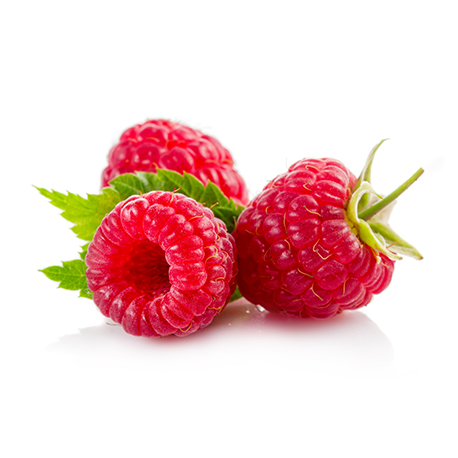
The raspberry belongs to the Rosaceae family. It is known for its very popular fruit: Raspberry. Raspberry is a small fruit with a delicate scent and balanced flavor: neither too sweet nor too tangy. It is eaten fresh, in compote, in jam or even dried. The drying stage concentrates its nutrients, which increases its fiber content. The small grains that we eat with its flesh contribute to its total insoluble fiber content. Thus, we appreciate dried raspberries for their laxative and cholesterol-lowering power. Latin name: Rubus ideus L. Botanical family: Rosaceae. Part used: Fruit.
This article was updated on 11/07/2023Recommended consumption
Dried Raspberry is a dried fruit. It therefore contains more sugar than a fresh Raspberry, the daily consumption recommendations are defined. As a classic treatment or for pleasure, a portion of dried Raspberry is estimated between 20 and 30 g per day, which represents around twenty dried Raspberries per day.
In what form ?
To make the most of their benefits, you can use them:
- Whole
- In pieces
At what time of the day ?
We advise you to use them during the following meal(s) to make the most of their benefits:
- Breakfast
- Lunch
- In case
- Dinner
What methods of use?
You can include them in the following preparations to make them easier to take:
- Salad
- Dessert
- Yogurt, dairy
- Flat
- Alone
- Mixed with other dried fruits
- Infusion
- Muesli
Health nutrition benefits
25 g of dried raspberries contain a significant portion of Nutritional References for the Population (RNP) in fibers.
As such, dried Raspberries can complement your healthy and varied diet.
Digestive system
Thanks to its flesh and seeds, Raspberries are rich in insoluble fiber. It fights against constipation by accelerating intestinal transit (see our guide constipation and diet).
Metabolism
Fiber reduces the absorption of cholesterol. They are called hypocholesterolemic. Dried Raspberries are naturally rich in fiber. As a result, they contribute to the management of cholesterol levels.
Nutritional properties
-
Laxative (fiber): among berries, raspberries are among the berries richest in fiber. The fibers are mostly insoluble (cellulose) thanks to the presence of its grains. In the presence of water, insoluble fibers become waterlogged. Within the digestive tract, they increase the mass of stools, which accelerates intestinal transit.
-
Lipid-lowering (fiber): fiber reduces the bioavailability of nutrients. This means that nutrient absorption is less. Cholesterol and triglycerides therefore also see their absorption decrease.
Nutritional values
| Nutritional elements | per 100g | for 25g | % of RDA* per 100 g | % of RDA* for 25 g |
| Energy (Kcal) | 290 | 58 | 14 | 2 |
| Energy (Kj) | 1213 | 291 | 14 | 2 |
| Lipids (g) | 2.89 | 0.43 | 4 | 1 |
| Saturated fatty acids (g) | 0.17 | 0.02 | 1 | 0 |
| Carbohydrates (g) | 51.86 | 7.77 | 20 | 3 |
| Including sugars (g) | 46.23 | 6.9 | 51 | 8 |
| Dietary fiber (g) | 16.83 | 2.52 | ||
| Protein (g) | 3.2 | 0.48 | 6 | 1 |
| Salt (g) | 0.07 | 0.01 | 1 | 0 |
*recommended daily allowance
Learn more about the plant: The raspberry tree
The raspberry is a shrub of the Rosaceae family. Due to its thorns which adorn its stems, and its character as a woody plant, the raspberry easily enters into plants called “brambles”. Their white flowers point at the tips of their petals at the beginning of summer. They will give birth to the globular, red and popular fruit: the Raspberry. The raspberry tree thrives in temperate regions, in the shade of forests. Different cultivars and varieties of Raspberries are available around the world; the main producers of Raspberries are Russia, Mexico, Serbia, Poland, the United States and Spain.
Was this article helpful to you?
Average grade: 5 ( 4 votes)
Bibliography
Publication: Baby B, Antony P, Vijayan R. Antioxidant and anticancer properties of berries. Crit Rev Food Sci Nutr. 2018;58(15):2491-2507. doi:10.1080/10408398.2017.1329198. Epub 2017 Aug 14. PMID: 28609132.
Website : Everything you need to know about raspberries. (nd). Interfel. https://www.lesfruitsetlegumesfrais.com/fruits-legumes/petits-fruits-et-fruits-rouges/Framboise/tout-savoir-sur-la-Framboise
Website : eFlore. (nd-g). Tela Botanica. https://www.tela-botanica.org/eflore/?referential=bdtfx&module=fiche&action=fiche&num_nom=58196&onglet=description


